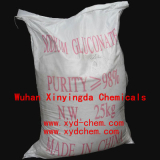sodium gluconate tech. grade uses
-
- Category :
Inorganic chemicals/Inorganic salts
- CAS NO : 527-07-1
- EC NO : 208-407-7
- Molecular Formula : C6H11NaO7
- Main Specifications : purity: 98% min, Loss on drying: ≤1.0%
- Synonyms : SODIUM GLUCONATE RE;Gluconic Acid Sodium;Sodium gluconate;sodium 2,3,4,5,6-pentahydroxyhexanoate (non-preferred name);D-Gluconic acid, monosodium salt;Gluconic acid sodium salt;
Package: Packed in plastic film bag wrapped with plastic woven sack with a net weight of 25kg each.
Uses : water reducer, retarder
Molecular Structure:

Product description:
sodium gluconate is one of the best retarder in the whole market, which the setting time can go up to 12 hours.
It can be also called 1.sodium gluconate, 2. Gluconate sodium 3. Sodium gluconate industrial grade 4. Sodium gluconate technical grade 5. Na Gluconate 6. SG 7. Gluconate Na 8. Retarder 9. Water reducer
The outstanding property of sodium gluconate is its excellent chelating power, especially in alkaline and concentrated alkaline solutions. It forms stable chelates with calcium, iron, copper,t aluminium and other heavy metals, and in this respect, it surpasses all other chelating agents, such as EDTA, NTA and related compounds.
Sodium gluconate is also a highly efficient set retarder and a good plasticiser / water reducer for concrete, mortar and gypsum. Sodium gluconate is used to clean metal and glass, with applications such as bottle washing, food service and utensil cleaning, food process equipment cleaning, and paint removal. Aqueous solutions of sodium gluconate are resistant to oxidation and reduction, even at high temperatures.
It is easily degraded biologically (98% after 2 days), and thus presents no wastewater problem.
Sodium gluconate has important effects for maintaining the osmotic pressure and volume of exocellular fluid, regulating the acid-base balance in human body and developing the normal functions of the nerves and muscles. The product is able to prevent effectively sodium-deficit syndromes from occurring.
Sodium gluconate is mainly used as a kind of retarding admixtures. Retarding admixtures (retarders) are known to delay hydration of cement without affecting the long-term mechanical properties. They are used in concrete to offset the effect of high temperatures, which decrease setting times, or to avoid complications when unavoidable delays between mixing and placing occur . Use of set retarders (sodium gluconate) in concrete pavement construction:
1) enables farther hauling, thus eliminating the cost of relocating central mixing plants;
2) allows more time for texturing or plastic grooving of concrete pavements;
3) allows more time for hand finishing around the headers at the start and end of the production day;
4) helps eliminate cold joints in two-course paving and in the event of equipment breakdown .
